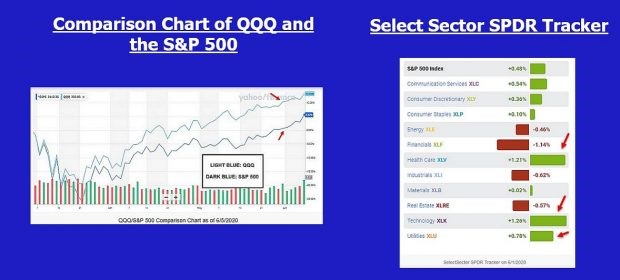Covered-call writers and sellers of cash-secured puts know the importance of portfolio diversification. If one security under-performs, the others can compensate, states Alan Ellman of The Blue Collar Investor.
This article will demonstrate how to craft a portfolio of large-cap tech and blue-chip companies for our option-selling strategies.
Strategy Goals
- Portfolio mix of blue-chip and technology companies
- User-friendly system
- Broad diversification
- Initial one-month time-value return goal range of 1%-3%
Large-Cap Technology Companies
We will use the Invesco QQQ Trust (QQQ), which consists of 100 of the largest non-financial companies listed on the Nasdaq exchange (MSFT, AAPL, AMZN, FB, INTC, etc.). One security will represent a broad diversification of quality technology companies.
Blue-Chip Companies
We will use the best-performing Select Sector SPDRs, which divide the S&P 500 into 11 sector index funds that each trade as stocks:
- Consumer Discretionary (XLY)
- Consumer Staples (XLP)
- Energy (XLE)
- Financials (XLF)
- Health Care (XLV)
- Industrials (XLI)
- Materials (XLB)
- Real Estate (XLRE)
- Technology (XLK)
- Utilities (XLU)
- Communications (XLC)
Evaluating the Price Performance of Our Securities
We can create a comparison chart for QQQ vs. the S&P 500 in one-month and three-month time frames and check the Select Sector SPDR Tracker also for one- and three-month price performance (as of June 2020):

QQQ and Select Sector SPDRs Price Performances
Real-Life Calculations with a 1%-3% Monthly Initial Time-Value Return Goal Range
Using a portfolio consisting of QQQ, XLK, XLU and XLV, the multiple tab of the Ellman Calculator shows an average one-month initial time-value return of 2.4% (yellow field) with an additional upside potential component of 0.4% (brown field):

Covered Call Writing Calculations
Discussion
A practical way of selecting blue-chip S&P 500 stocks is by locating the top-performing Select Sector SPDRs. Similarly, a time-efficient way of incorporating tech companies into our option-selling portfolios is by using the Qs. An initial one-month time-value return goal range of 1%-3% is reasonable using slightly out-of-the-money strikes.
Learn more about Alan Ellman on the Blue Collar Investor Website.

















